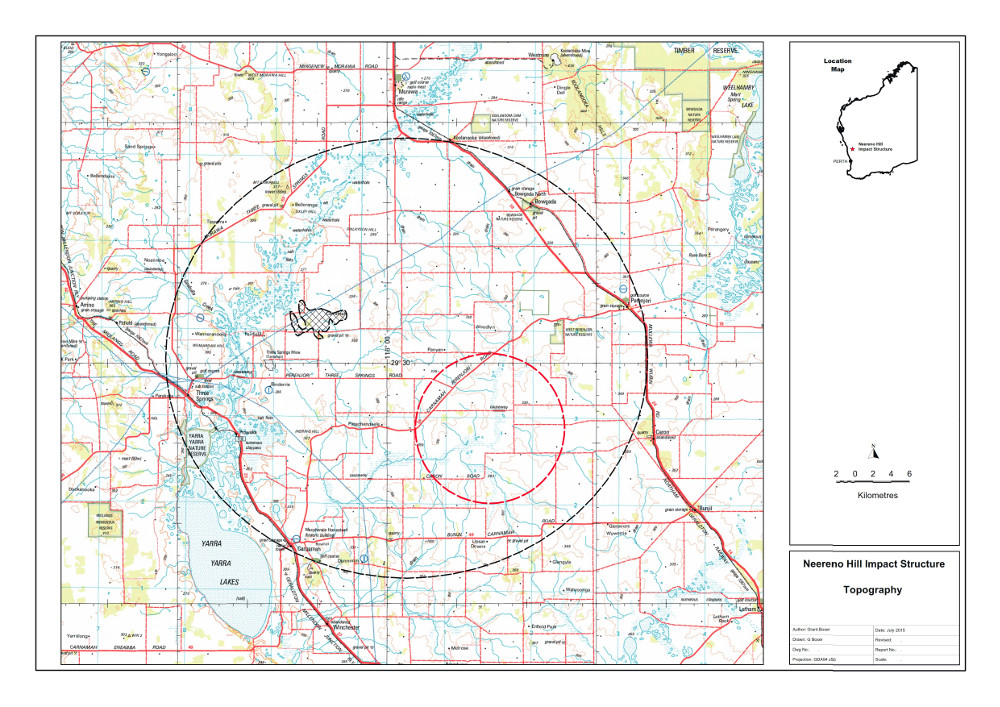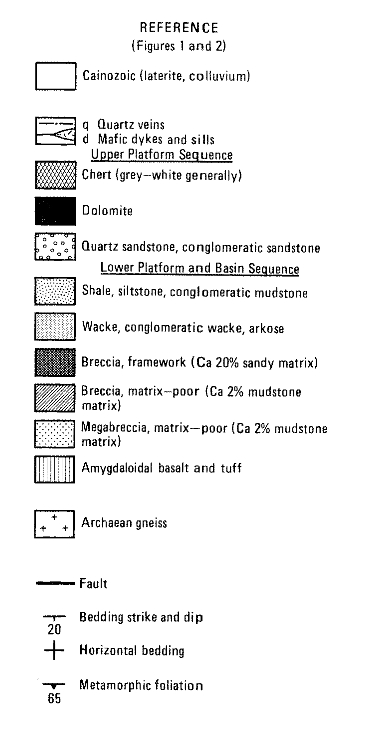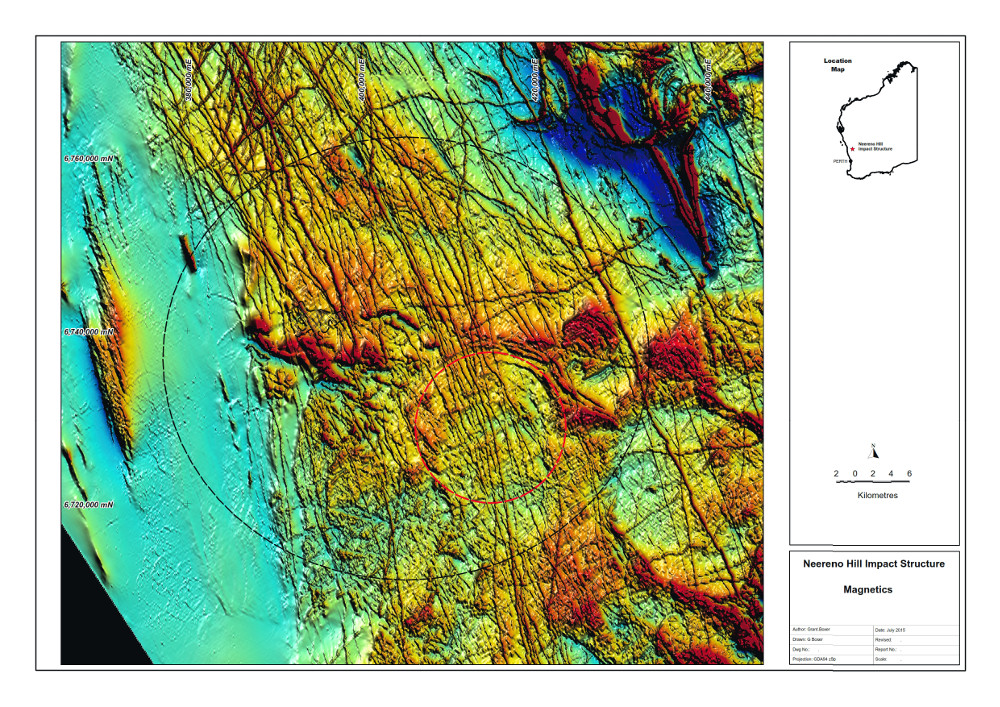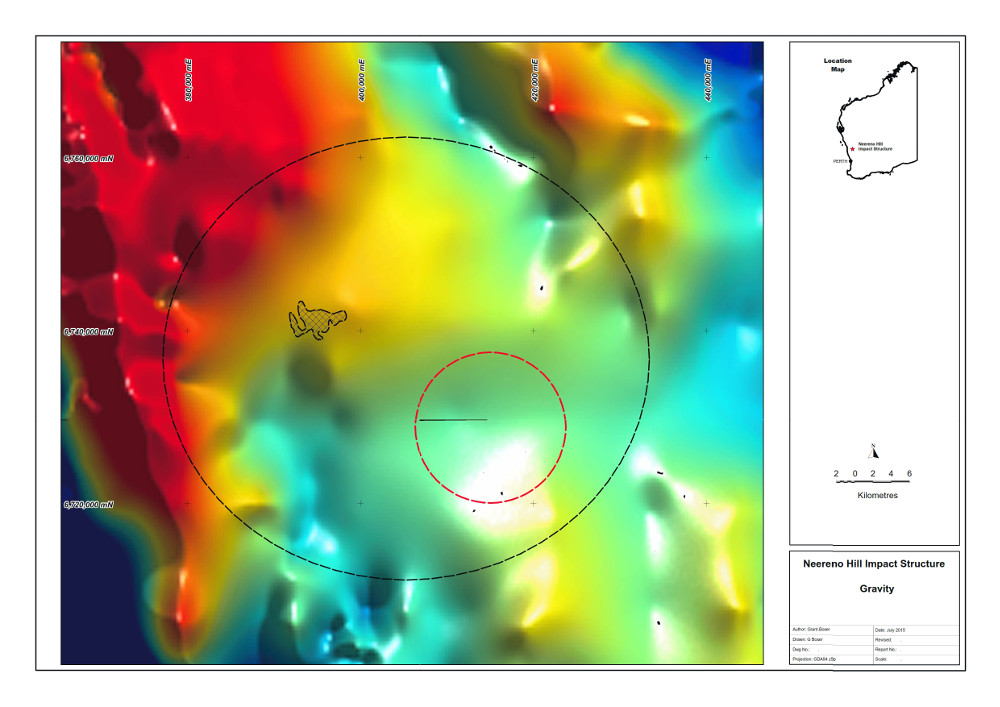Neerino Hill Possible Impact Structure
As part of my private research into impact craters and impact structures, I have been examining the geology of Western Australia looking for oddities in the geological record that may be indicative of an impact event. The Neereno Hill area area contains outcrops of coarse angular breccias which are out of character for a shallow marine marginal basin. The breccias were first identified by Lipple (1984) who interpreted the breccias to have been formed by mass flow transport in steep terrain and as valley fills. I visited the area initially in July 2015 and examined a number of outcrops mapped by Lipple as breccia. A few samples were collected and some samples were sent for thin section to examine the rocks for any microscopic evidence for an impact origin.
A recent field trip with Aaron Carvosie and Raiza Raquel Quintero Mendez from the School of Earth and Planetary Science at the Curtin University in Perth tentatively identified melt rocks and melt fragments in the Neereno Hill breccias. They collected samples for the extraction of zircons seeking grains with impact features and possible dating.
The images below illustrate the features found during my field visit which indicated that there is a strong possibility that this is a new discovery of an impact structure in Western Australia. I have provisionally called this feature the "Neereno Hill Possible Impact Structure" (NHPIS).
The NHPIS is located in the mid-west region of Western Australia. It is located at 119 deg 56 min east and 29 deg 27 min south on the Perenjori SG50-06 1:250 000 mapsheet and the Billeranga 2039 1:100 000 mapsheet. The extent of the structure is yet to be determined and future field trips are planned to check the extent of the impact features.
Recent field trips have provisionally identified Polymict Breccia with Melt Fragments ("Seuvite") and clast-rich to clast-free melt rocks. The breccias and melt rocks are cut by felsic and mafic dykes. The mafic dykes appear to be part of the Yilgarn mafic dyke suite in this area (Mando Morne dyke suite) which have been dated at about 1200 Ma (windgatexxx). The age of the felsic dykes are currently unknown but may be related to the impact.
I am currently compiling data on the NHPIS and a pdf of my working draft can be found here here. All figures and images have been produced by myself unless noted otherwise.
Location map for the Neereno Hill Possible Impact Structure (Google Earth)

Distribution of breccias at the Neereno Hill Possible Impact Structure (source 1:250 000 topographic map series)

Geological map from Lipple (1984) showing the location of the breccias mapped by Lipple (see figure 3 for geological legend)..

Geological legend from Lipple's geological map (see figure 2).
The identification of a possible impact structure was the result of the recognition by the author of breccias with strong similarities to lithic breccia described from many impact structures around the world. Psuedotachylites and melt rocks(see images below) indicate possible impact melt rocks. This possible impact structure has not been recognised previously and is a new discovery. Examination of thin sections to date has not identfied any pdf's in quartz grains or any other diagnostic impact related features. The breccias appear to comprise parautochthomous lithic breccias and pseudotachylite breccias.
Field Photos
Relatively fine grained lithic breccia, Neereno Hill breccia (Photo G Boxer July 2015).
Medium grained lithic breccia, Neereno Hill breccia. (Photo G Boxer July 2015).
Typical megabreccia, Neereno Hill breccia. (Photo G Boxer July 2015).
Vein of possible psuedotachylite vein. (Photo G Boxer July 2015).
Granite breccia with possible pseudotachylite matrix. (Photo G Boxer July 2015).
Pavement of megabreccia with possible pseudotachylite matrix and entrained clasts. (Photo G Boxer July 2015).
Possible shatter cones on the surface of a granitic gneiss clast. Not entirely convincing and the search is continuing for better evidence (Photo G Boxer July 2015).
Sawn Rock Slabs
Sawn slab showing possible pseudotachylite. (Photo G Boxer July 2015).
Possible impact melt with entrained granite clasts (Photo G Boxer July 2015).
Possible impact breccia (Photo C Lawrence August 2017).
Possible impact breccia (Photo C Lawrence August 2017).
Possible impact breccia (Photo C Lawrence August 2017).
Thin Sections
Sample GB10
Angular broken quartz grains with fractured feldspar grains in fine grained recrystallised possible psuedotachyite from sample site GB10(FOV 15 mm).
Angular broken quartz grains with fractured feldspar grains in fine grained recrystallised possible psuedotachyite from sample site GB10(FOV 2 mm, plane polarised light).
Angular broken quartz grains with fractured feldspar grains in fine grained recrystallised possible psuedotachyite from sample site GB10(FOV 2 mm, polarised light).
Geology and Geophysics

Total Magnetic Intensity Image of the Neereno Hill area. Note there does not appear to be any magnetic features associated with the breccia outcrops but there is a distinct circular feature to the east of the breccias.

Gravity Image of the Neereno Hill area indicating no significant gravity features over the breccia outcrop area.
Please note the Neereno Hill area is private land and permission is required to visit the exposures.
References
Baxter J L and Lipple S L. 1985. Perenjori, Western Australia, 1:250 000 Geological Series - Explanatory Notes, Geological Survey of Western Australia, Perth.
Lipple S L. 1984. Proterozoic Mass-Transported Breccias, Neereno Hill, Western Australia. Geological Survey of Western Australia, Proffessional Papers 1982, GSDRpt12_n7.
Other Impact Sites of Western Australia
Glikson
Gnargoo
Goat Paddock
Ilkurka
Lennis
Neereno Hill Possible Impact Structure
Piccaninny
Skirmish
Spider
Veveers
Woodliegh